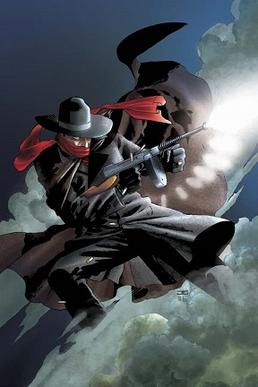
The Shadow is a fictional character published by magazine publishers Street & Smith and writer Walter B. Gibson. Originally created to be a mysterious radio show narrator, and developed into a distinct literary character in 1931 by writer Walter B. Gibson, The Shadow has been adapted into other forms of media, including American comic books, comic strips, serials, video games, and at least five feature films. The radio drama included episodes voiced by Orson Welles.

The Rocketeer is a fictional American comic book character, created by writer/artist Dave Stevens, the character first appeared in 1982 and is an homage to the Saturday matinee serial heroes from the 1930s through the 1950s.

Mike Grell is an American comic book writer and artist, known for his work on books such as Green Lantern/Green Arrow, The Warlord, and Jon Sable Freelance.
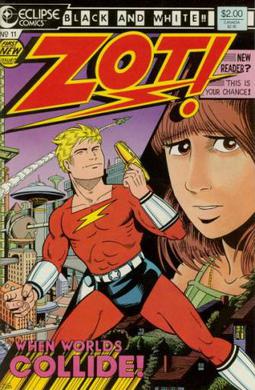
Zot! is a comic book created by Scott McCloud in 1984 and published by Eclipse Comics until 1990 as a lighthearted alternative to the darker and more violent comics that dominated the industry during that period. There were a total of 36 issues, with the first ten in color and the remainder in black and white.

Airboy is a fictional Golden Age aviator hero of an American comic book series initially published by Hillman Periodicals during the World War II, before ending his initial run in 1953. The hero was the costumed identity of crack pilot Davy Nelson II, and created by writers Charles Biro and Dick Wood with artist Al Camy.

Eclipse Comics was an American comic book publisher, one of several independent publishers during the 1980s and early 1990s. In 1978, it published the first graphic novel intended for the newly created comic book specialty store market. It was one of the first to offer royalties and creator ownership of rights.
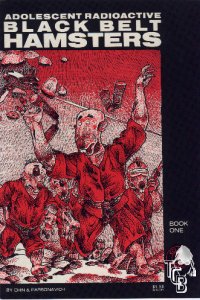
Adolescent Radioactive Black Belt Hamsters is a creator-owned American funny-animal parody comic book series created by Don Chin. It was one of a number of parodies of Mirage Studios' hit Teenage Mutant Ninja Turtles series, itself a parody of popular eighties comics such as Frank Miller's Daredevil and Ronin; others included Naive Inter-Dimensional Commando Koalas and Pre-Teen Dirty-Gene Kung-Fu Kangaroos.

Scout is an American dystopian comic book series created and written by Timothy Truman, and first published by Eclipse Comics in 1985. The story stars a Native American Apache named Emanuel Santana. The setting of the series is a future United States that has become a Third World country.
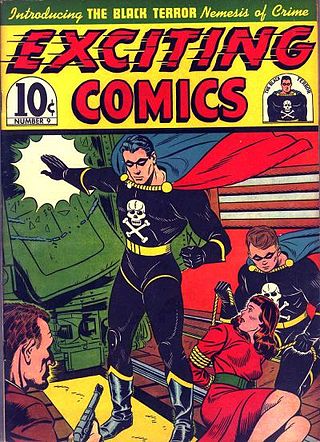
The Black Terror is a fictional comic book superhero who originally appeared in Exciting Comics #9, published by Nedor Comics in January 1941. The character was popular, and on the strength of the Black Terror's sales, Nedor made Exciting Comics a monthly magazine starting with issue #11.

Alien Encounters is an American science fiction anthology comic book published by FantaCo Enterprises and then Eclipse Comics. The comic debuted with FantaCo in 1981, and in 1985 was taken over by Eclipse.

The Masked Man is a fictional comic book crime-fighter created by B.C. Boyer and published by Eclipse Comics. His first appearance was in Eclipse #7, dated November 1982. The Masked Man is the alter ego of private eye Dick Carstairs, who takes on the identity of the Masked Man so that his friend Barney McAllister, a reporter, could grab headlines using tales of his crime-fighting adventures.

Total Eclipse is an American comic book limited series in five prestige format parts published by Eclipse Comics in 1988 to 1989. A cross-company crossover commemorating the company's tenth anniversary, Total Eclipse was intended to bring all of the company's characters together, no matter how obscure or bizarre. These included Airboy and the Air Fighters, Strike! and Sgt. Strike, Prowlers Leo Kragg and Tim Kida, Aztec Ace, The Liberty Project, Miracleman, The New Wave and Beanish.

William Murray is an American novelist, journalist, short story, and comic book writer. Much of his fiction has been published under pseudonyms. With artist Steve Ditko, he co-created the superhero Squirrel Girl.

Superhero fiction is a genre of speculative fiction examining the adventures, personalities and ethics of costumed crime fighters known as superheroes, who often possess superhuman powers and battle similarly powered criminals known as supervillains. The genre primarily falls between hard fantasy and soft science fiction spectrum of scientific realism. It is most commonly associated with American comic books, though it has expanded into other media through adaptations and original works.

The Spider's Web is a 1938 Columbia Pictures movie serial based on the popular pulp magazine character The Spider. The first episode of this 15-chapter serial was double-length and directed by serial and western specialist Ray Taylor and by comedy and serial veteran James W. Horne; it was the fifth of the 57 serials released by Columbia.
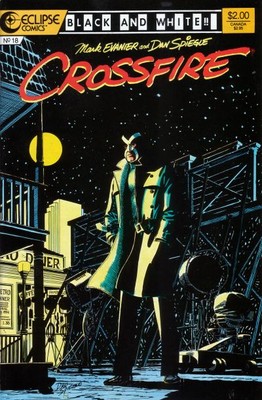
Crossfire is an American comic book series created by writer Mark Evanier and artist Dan Spiegle originally for Eclipse Comics. It was a spin-off from DNAgents, which was also written by Evanier. The series ran for 26 issues from May 1984 to October 1988.
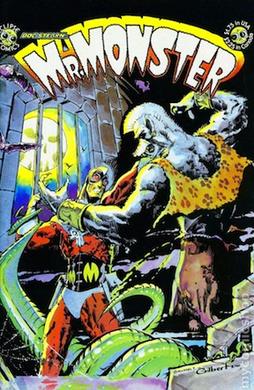
Doc Stearn...Mr. Monster is a comic book featuring a superhero created by Michael T. Gilbert, most recently published by Dark Horse Comics.

Strike! is an American creator-owned superhero comic book series created by writer Chuck Dixon and artist Tom Lyle, published by Eclipse Comics between 1987 and 1988. It concerns about a teenage boy who finds the power harness of Sgt. Strike, a hero that fought for the US in World War II before disappearing.

The Prowler is a creator-owned American comic book series created by Timothy Truman and John K. Snyder III. It was published by Eclipse Comics between 1987 and 1988, and chronicled the adventures of 1930s vigilante Leo Kragg, a.k.a. The Prowler, as he trained teenager Scott Kida to take up his legacy.




















